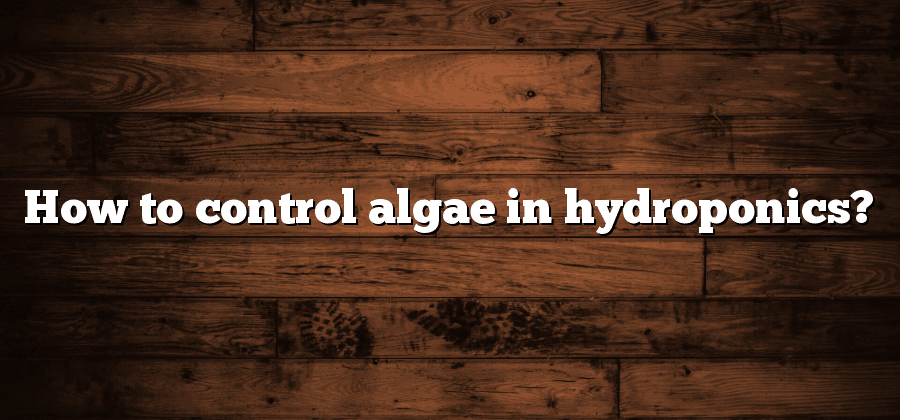Understanding Algae Growth in Hydroponics
Algae growth is a common concern in hydroponic systems that can have detrimental effects on plant health and overall system performance. Understanding the factors that contribute to algae formation is essential for hydroponic growers to effectively prevent and manage infestations.
One major factor that promotes algae growth is excess nutrients in the hydroponic solution. When nutrient levels are too high, algae can thrive and quickly reproduce, competing with the plants for resources. To minimize the risk of algae infestation, it is crucial to maintain proper nutrient levels by closely monitoring and adjusting the nutrient solution according to the specific needs of the plants being grown. Additionally, ensuring a balanced nutrient ratio can help discourage algae growth and promote healthy plant development.
Preventing Algae Infestation in Hydroponic Systems
Hydroponic systems offer a controlled environment for growing plants without the use of soil. While this method of cultivation can be highly effective, it is not immune to certain challenges, one of which is algae infestation. Algae, a type of aquatic organism, can thrive in hydroponic systems if not properly managed. However, by implementing a few preventive measures, growers can minimize the risk of algae growth and maintain a healthy and productive system.
The first step in preventing algae infestation is to maintain proper water quality. Algae flourish in nutrient-rich environments, so it is crucial to regularly monitor and adjust nutrient levels in the hydroponic solution. By ensuring a balance between essential nutrients and their concentrations, growers can create an environment that is less conducive to algae growth. Additionally, using high-quality water and filtering it before introducing it into the system can help eliminate any potential sources of algae spores. By focusing on water quality, growers lay a solid foundation for a healthy hydroponic system that is less susceptible to algae infestation.
Maintaining Proper Nutrient Levels to Minimize Algae Growth
To minimize algae growth in hydroponic systems, it is crucial to maintain proper nutrient levels. Algae thrive in environments rich in nutrients, particularly nitrogen and phosphorus. Therefore, it is essential to monitor and adjust the nutrient solution to ensure that it remains within the optimal range for plant growth without providing excess nutrients for algae.
Regularly testing the nutrient solution is a good practice to ensure that it is balanced and within the desired range. This can be done using various testing kits available in the market. By measuring the nutrient levels, hydroponic growers can make necessary adjustments and fine-tune the solution to meet the specific needs of the plants while limiting the availability of nutrients for algae growth. It is important to note that maintaining proper nutrient levels is not only essential for algae control but also for the overall health and productivity of the plants in hydroponic systems.
Controlling Light Exposure to Reduce Algae Formation
Algae growth can be a persistent problem in hydroponic systems, often leading to reduced nutrient availability and poor plant health. One effective method of preventing algae formation is by controlling light exposure.
Light is a crucial factor in algae growth, as it provides them with the energy they need for photosynthesis. By restricting light exposure, we can limit the conditions that promote algae growth. This can be achieved by using light-blocking materials such as opaque covers or shading devices to prevent direct sunlight from reaching the nutrient solution. Additionally, implementing a regular schedule for turning off the grow lights during the dark period can further reduce the likelihood of algae formation.
Proper light management is essential in maintaining a clean and efficient hydroponic system. By understanding the impact of light on algae growth and taking appropriate measures to control light exposure, growers can minimize the occurrence of algae infestation and promote healthier plant growth.
Implementing a Regular Cleaning and Maintenance Routine
Proper cleaning and maintenance are crucial for the success of any hydroponic system. Regular cleaning not only helps to prevent the growth of algae but also ensures the overall health of the plants. One key aspect of a cleaning routine is to regularly flush out the nutrient solution and replace it with fresh, clean water. This helps to remove any excess nutrients that may accumulate and create an environment conducive to algae growth. It is recommended to perform this task at least once every two weeks, or more frequently if necessary.
In addition to flushing the system, it is important to clean all the components of the hydroponic setup regularly. This includes the reservoir, pumps, and any tubing or piping. A mild detergent or hydrogen peroxide solution can be used to clean these parts, ensuring that any debris or residue is effectively removed. It is also essential to inspect and clean the grow medium on a regular basis, as it can potentially harbor algae spores or other contaminants. By adhering to a regular cleaning and maintenance routine, hydroponic growers can effectively minimize the risk of algae infestation and promote the optimal growth of their plants.






